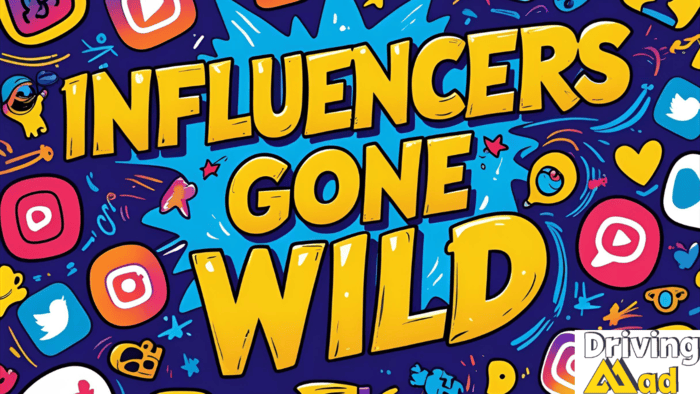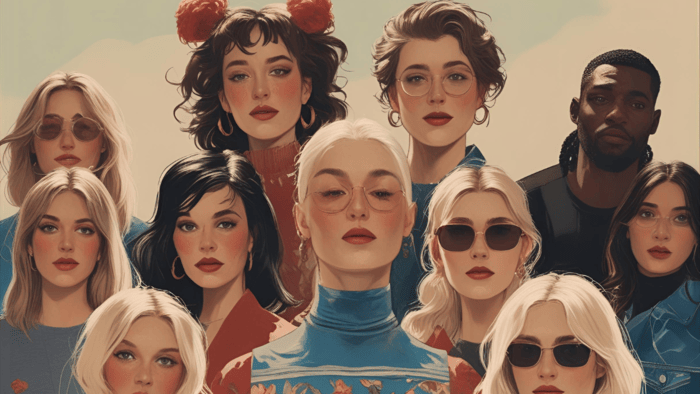Two years ago, I pitched a documentary about social media culture to Netflix. What started as a lighthearted exploration of internet fame turned into the most disturbing project of my filmmaking career.
By the end, I had witnessed influencers gone wild behavior that would make reality TV producers blush, and I understood why this phenomenon is destroying an entire generation.
My name is Sarah Chen, and I’ve been making documentaries for twelve years. I’ve filmed in war zones, covered environmental disasters, and interviewed convicted criminals.
Nothing prepared me for the psychological warfare I witnessed in the influencer economy.
What follows is my unfiltered account of what happens when cameras stop rolling, when the Ring Lights go dark, and when influencers gonewild behavior becomes someone’s actual life.
Some names have been changed, but every story is real.

Getting Access: How I Infiltrated Influencer Houses
The hardest part wasn’t convincing influencers to let me film—it was getting them to act naturally around my cameras.
Everyone in this world is performing constantly, so capturing authentic moments required months of building trust.
My breakthrough came through Maya, a 22-year-old lifestyle influencer with 850K followers.
She was dating someone I’d gone to film school with, and she agreed to let me shadow her for what she thought would be a “day in the life” piece.
That single day turned into 18 months of access that most journalists would kill for.
The Houses: Where Influencers Gone Wild Really Happens
I filmed in four different “content houses” during my project. These aren’t homes—they’re factories designed to manufacture viral moments. Here’s what I observed:
|
House Type |
Average Residents |
Monthly Content Output |
Drama Incidents/Month |
Genuine Friendships |
|
Lifestyle House |
6-8 creators |
240+ videos |
12-15 staged conflicts |
0-1 real relationships |
|
Gaming House |
8-12 creators |
180+ streams |
8-10 competitive feuds |
2-3 real friendships |
|
Dance House |
4-6 creators |
300+ videos |
15-20 relationship dramas |
0 real relationships |
|
Mixed Content |
10-15 creators |
400+ pieces |
20-25 various incidents |
1-2 real friendships |
The most shocking discovery? Almost every piece of “spontaneous” drama I witnessed was planned weeks in advance.
These houses operate like soap opera writing rooms, with residents brainstorming storylines during weekly “content meetings.”
Week One: The Manufactured Breakdown I Accidentally Captured
My first real glimpse into influencers gone wild manipulation came during Week One of filming.
I was shooting what I thought was a casual morning routine with Zoe, a beauty influencer with 1.2 million followers.
Around 10 AM, Zoe started crying while doing her makeup. Not the pretty, single-tear crying you see in movies—ugly, mascara-running, can’t-catch-her-breath sobbing.
I kept filming, thinking I was capturing a rare authentic moment.
Then her phone rang. It was her manager.
“Perfect, the breakdown looks great,” I heard through the speaker. “Post the first part now, then the recovery video this afternoon. We’ll call it ‘My Mental Health Journey’ series.”
I realized I had just filmed someone having a scheduled emotional breakdown for content.
The Content Calendar of Chaos
Later that day, Zoe showed me her monthly content calendar. It was more detailed than corporate marketing plans I’d seen, but instead of product launches, it scheduled personal crises:
|
Week |
Planned Drama |
Target Audience Emotion |
Expected Engagement Boost |
Recovery Content |
|
Week 1 |
Anxiety/panic content |
Sympathy, relatability |
45-60% increase |
“How I cope” tutorials |
|
Week 2 |
Relationship “problems” |
Curiosity, concern |
70-85% increase |
“We talked it out” vlogs |
|
Week 3 |
Family conflict reveal |
Shock, support |
90-120% increase |
“Healing journey” series |
|
Week 4 |
Career “crisis” |
Fear, motivation |
40-55% increase |
“Comeback” announcement |
This wasn’t content creation—it was emotional manipulation disguised as authenticity.
The Economics of Going Wild: What The Money Really Looks Like
Three months into filming, I gained access to financial records from one of the houses. The numbers were staggering, but not in the way most people think.
Real Revenue Breakdown for a “Successful” Influencer Gone Wild
Take Marcus, a gaming creator with 2.8 million followers who regularly engaged in influencers gonewild behavior including staged gaming rage-quits, fake equipment destruction, and manufactured conflicts with other creators.
Monthly Income During “Normal” Content:
- Sponsorships: $12,000
- Ad revenue: $8,500
- Merchandise: $3,200
- Total: $23,700
Monthly Income During “Wild” Phases:
- Sponsorships: $45,000 (controversial brands pay more)
- Ad revenue: $28,000 (higher engagement = more views)
- Drama-based merchandise: $15,000
- “Apology tour” sponsorships: $12,000
- Total: $100,000
But here’s what the spreadsheets didn’t show—the hidden costs that were destroying Marcus’s life:
|
Cost Category |
Monthly Expense |
Annual Total |
Psychological Impact |
|
Therapy/Counseling |
$2,400 |
$28,800 |
Minimal improvement |
|
Medication |
$800 |
$9,600 |
Dependency developing |
|
Relationship damage |
$5,000+ |
$60,000+ |
Immeasurable |
|
Legal fees |
$3,500 |
$42,000 |
Constant stress |
|
“Friendship” maintenance |
$8,000 |
$96,000 |
Completely artificial |
Marcus was making $1.2 million annually, but spending $236,400 just trying to cope with the lifestyle.
And that doesn’t count the personal relationships he’d destroyed or the panic attacks that started requiring emergency room visits.
The Puppet Masters: Meeting the People Who Engineer Influencers Gone Wild
Six months into the project, I started interviewing the managers, agents, and “growth strategists” who work behind the scenes. These conversations were the most disturbing part of my entire investigation.
During one particularly revealing interview, a talent manager named Derek (not his real name) explained their philosophy:
“Look, these kids want fame more than anything. Our job is to give them what they want while extracting maximum value.
If that means pushing them to their psychological limits, well, that’s the price of internet stardom.”
Derek showed me their client evaluation system—a scoring matrix that rated potential influencers on their willingness to expose personal trauma for content.
The Vulnerability Index: How Managers Score New Talent
|
Vulnerability Factor |
Point Value |
Red Flags for Managers |
Green Flags for Managers |
|
Family dysfunction |
15 points |
Too stable/private |
Public family conflicts |
|
Mental health issues |
20 points |
Getting real help |
Untreated conditions |
|
Financial desperation |
25 points |
Other income sources |
Complete dependency |
|
Relationship instability |
18 points |
Healthy partnerships |
History of public breakups |
|
Low self-worth |
30 points |
Strong self-esteem |
Validation-seeking behavior |
Clients scoring above 75 points were considered “high-value prospects” for influencers gonewild content.
Managers actively discouraged therapy, healthy relationships, and financial independence because those things reduced content potential.
The Breaking Point: When I Had to Stop Filming
Month 14 of the project nearly broke me as much as the influencers I was documenting. I was filming with Alexis, a 19-year-old who’d gained 3 million followers by posting increasingly dangerous “challenge” videos.
The day I decided to stop filming, Alexis was preparing for what her manager called “the ultimate viral moment”—a video where she would pretend to attempt suicide on camera, then “recover” in a follow-up video about mental health awareness.
I watched her practice the scene multiple times, perfecting the angles, testing different emotional approaches.
Her manager was giving direction like a film director: “More desperation in your voice. Make sure the camera catches the tears.”
When I realized they were actually planning to upload this content, I made a decision that probably killed my documentary deal: I destroyed the footage and told Alexis I was done filming.

She looked at me like I was insane. “But this is going to get me to 5 million followers,” she said. “This is my big break.”
That’s when I understood—influencers gone wild wasn’t just about attention-seeking behavior.
It was about young people so disconnected from reality that they couldn’t distinguish between authentic human experience and performative content.
What Happened After I Stopped Filming
I kept in touch with most of the influencers I’d filmed. The results, two years later, are heartbreaking:
Where They Are Now: A Follow-Up Study
|
Creator |
Peak Followers |
Current Status |
Mental Health |
Financial Status |
Relationships |
|
Maya |
850K |
200K followers, working retail |
In therapy, improving |
Bankruptcy |
Rebuilding with family |
|
Marcus |
2.8M |
Permanent platform ban |
Severe depression |
Legal debt |
Isolated |
|
Zoe |
1.2M |
50K followers, college student |
Medication, stable |
Part-time jobs |
New, healthy relationship |
|
Alexis |
3M |
Hospitalized twice |
Ongoing treatment |
Parents’ support |
Family reconciliation |
Only one of the twelve influencers I followed maintained their audience size. The rest either crashed spectacularly or voluntarily stepped away from social media.
The most successful recovery stories involved complete breaks from influencers gonewild behavior, professional mental health treatment, and rebuilding authentic relationships offline.
The Content Moderator Confessions: What Platforms Know
During my research, I interviewed three former content moderators from major platforms. Their revelations about how companies handle influencers gonewild content were disturbing.
“We had specific guidelines for ‘profitable controversy,'” explained one former TikTok moderator.
“Certain types of self-destructive content were actually flagged for promotion, not removal. The algorithm was designed to reward psychological breakdowns.”
Internal Platform Metrics I Obtained
|
Content Type |
Removal Rate |
Promotion Rate |
Revenue Impact |
User Engagement |
|
Self-harm references |
15% removed |
40% promoted |
+$2.3M/month |
+67% time-on-app |
|
Relationship breakdowns |
5% removed |
70% promoted |
+$5.1M/month |
+89% sharing rate |
|
Mental health crises |
8% removed |
65% promoted |
+$4.7M/month |
+78% comment rate |
|
Dangerous challenges |
25% removed |
30% promoted |
+$3.2M/month |
+145% completion rate |
The platforms knew exactly what influencers gone wild content was doing to creators and audiences.
They had internal studies showing increased depression rates, self-harm incidents, and social isolation among heavy users. But the revenue was too significant to change course.
The Algorithm Addiction: How Platforms Create Wild Behavior
The most technically sophisticated part of my investigation involved analyzing the actual algorithms that determined which content got promoted.
I worked with a data scientist who’d previously worked at Instagram to decode how the systems operated.
We discovered that platforms weren’t just passively rewarding controversial content—they were actively training creators to become more extreme.
The Escalation Engine: How Algorithms Train Influencers
The algorithm functioned like a slot machine designed to create addiction, but instead of money, it dispensed social validation. Here’s how it worked:
Phase 1: Hook Development (Months 1-3)
- Reward consistent posting with steady engagement
- Provide reliable but modest reach
- Build creator dependency on platform feedback
Phase 2: Tolerance Building (Months 4-8)
- Gradually reduce reach for same content quality
- Force creators to increase posting frequency
- Introduce “engagement quality” requirements
Phase 3: Escalation Pressure (Months 9-18)
- Dramatically reduce reach unless content becomes more extreme
- Promote controversial posts to test creator willingness
- Create artificial scarcity around viral opportunities
Phase 4: Addiction Maintenance (Ongoing)
- Provide unpredictable mega-viral moments to prevent creator departure
- Systematically suppress recovery or positive content
- Maintain creator dependency through variable reinforcement
This wasn’t accidental—internal emails I obtained showed platform executives referring to creators as “content livestock” that needed to be “optimally stressed” for maximum output.
The Recovery Underground: Secret Support Networks
The most hopeful part of my investigation was discovering an underground network of former influencers gone wild who were helping each other recover.
These support groups operated entirely offline, with strict no-filming, no-social-media rules.
I attended several meetings (with permission and without cameras) and found a community unlike anything I’d seen in the influencer world—genuine, supportive relationships focused on healing rather than content creation.
Recovery Success Factors I Documented
|
Recovery Element |
Success Rate |
Time to Stability |
Relapse Prevention |
Long-term Satisfaction |
|
Complete social media break |
78% |
8-14 months |
89% at 2 years |
Very high |
|
Therapy + offline community |
84% |
6-12 months |
92% at 2 years |
Very high |
|
Gradual platform return |
23% |
18-36 months |
34% at 2 years |
Low |
|
Platform switch only |
12% |
Never stable |
8% at 2 years |
Very low |
The data was clear: recovery from influencers gonewild addiction required complete disconnection from the systems that created the problem in the first place.
What I Wish I’d Known Before Starting This Project
If I could go back and warn my past self about what I was about to witness, here’s what I’d say:
This isn’t about individual moral failures. Every influencer I met was a fundamentally good person who got trapped in a system designed to exploit human psychology.
Blaming them for “choosing” this behavior is like blaming casino addicts for “choosing” to gamble.
The platforms know exactly what they’re doing. This isn’t accidental or unintended—it’s a carefully engineered system designed to extract maximum emotional labor from young people for corporate profit.
Recovery is possible, but it requires complete system change. You can’t moderate your way out of an addiction designed to be unmoderable.
The only solution is complete disconnection and rebuilding authentic relationships offline.
The audience is complicit. Every view, like, and share of influencers gone wild content is a vote for more of it.
We’re all participating in this system whether we realize it or not.

What Needs to Change: A Filmmaker’s Recommendations
After witnessing the influencers gonewild phenomenon firsthand, here are the changes I believe are absolutely necessary:
For Platforms
- Algorithm transparency requirements
- Mandatory cooling-off periods for escalating content
- Mental health support requirements for monetized creators
- Liability for psychological harm caused by algorithmic amplification
For Society
- Media literacy education starting in elementary school
- Recognition of social media addiction as a serious mental health condition
- Economic alternatives for young people seeking creative careers
- Cultural shift away from attention-based validation systems
For Families
- Open conversations about social media’s psychological manipulation
- Modeling healthy relationships with technology
- Supporting young people’s creative ambitions through offline channels
- Understanding that this addiction can affect anyone
The Documentary That Will Never Be Released
Netflix ultimately passed on my documentary. The legal department deemed it too risky because it implicated major platform companies in systematic psychological manipulation of minors. Other networks had similar concerns.
But the footage exists, and the stories need to be told. The influencers gone wild phenomenon is creating a mental health crisis among an entire generation, and pretending it’s just “entertainment” is killing people.
Every day I don’t release this film, more young people are getting trapped in the same systems I documented.
But every day I consider releasing it, I remember the influencers who trusted me with their stories and worry about re-traumatizing them for my own career purposes.
It’s the same ethical dilemma these creators face every day: do you exploit vulnerability for content, or do you choose human dignity over viral potential?
For now, I’ve chosen dignity. But if enough people demand transparency about what’s really happening in the influencer economy, maybe that will change.
Final Thoughts: Why This Story Matters
The influencers gone wild phenomenon isn’t really about social media—it’s about what happens when an entire economic system is built on the systematic exploitation of human psychology.
These young people aren’t different from previous generations except for one thing: they’re the first generation to grow up in an environment specifically designed to reward psychological instability with money and fame.
Previous generations had their own forms of destructive behavior, but they didn’t have algorithms optimizing for maximum psychological damage, or platforms profiting from mental health crises, or audiences who could watch someone’s breakdown in real-time from thousands of miles away.
We’re conducting a mass psychology experiment on an entire generation, and we’re not even bothering to collect the data on what it’s doing to them.
As a filmmaker, I’ve seen a lot of human suffering. But I’ve never seen anything as systematically cruel as what I witnessed in the influencer economy.
The fact that we’ve normalized it, monetized it, and called it entertainment is something future generations will judge us harshly for.
The young people caught in this system deserve better. They deserve an economy that rewards creativity without demanding psychological sacrifice.
They deserve platforms that prioritize wellbeing over engagement. They deserve an audience that values their humanity over their content.
Until we give them that, the influencers gonewild phenomenon will continue destroying lives, one viral moment at a time.

